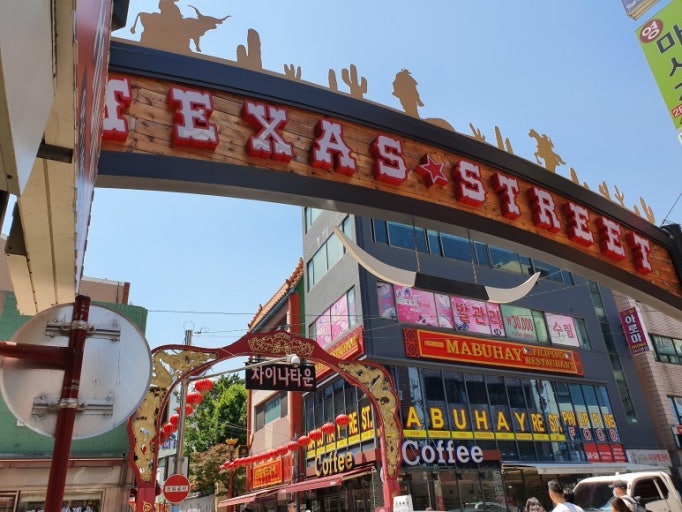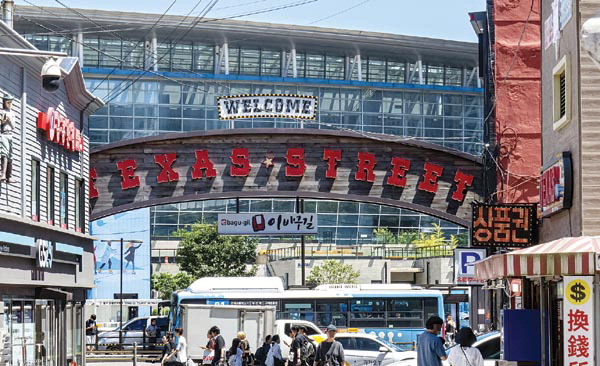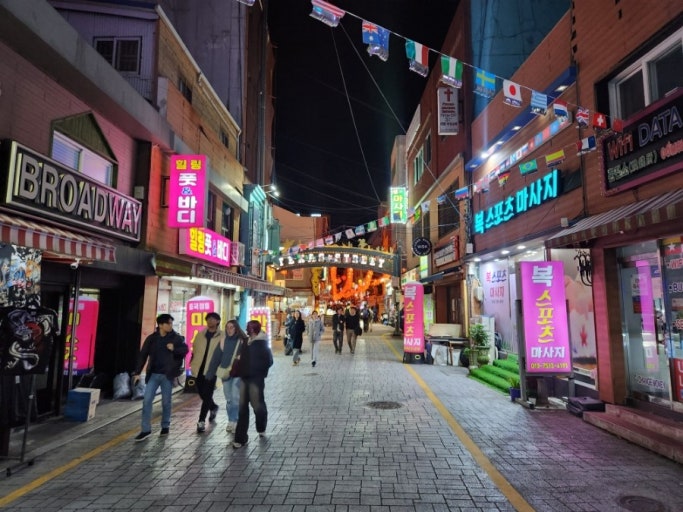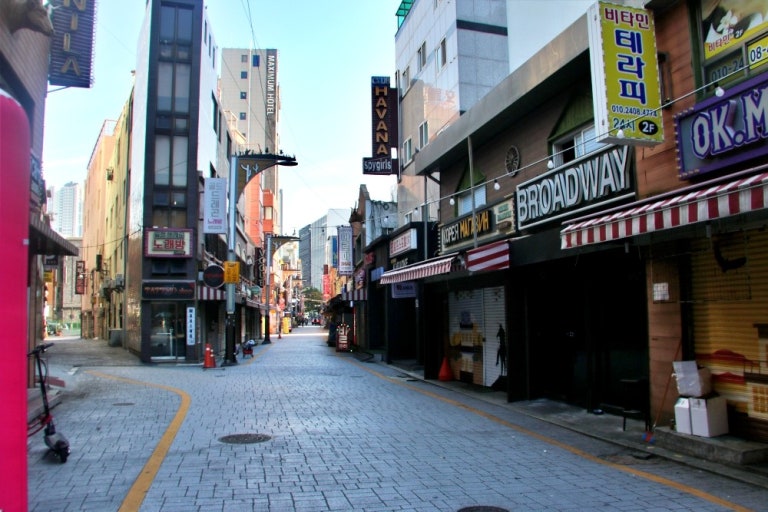Table of Contents
- In front of Busan Station, 'Texas Street' is no more?
- Background of sculpture removal: "Inappropriate for a gateway city image"
- Urban hollowing pilot project...Including improvements to pedestrian pathways
- The historical significance and future direction of Texas Street
- Conclusion: Shedding the old image, becoming a new tourist hub
- Frequently Asked Questions (FAQ)
In front of Busan Station, 'Texas Street' is no more?

The Texas Street near Busan Station, the gateway to Busan, is about to transform into a new appearance. After a long controversy, the decision has been made to demolish the arched 'Texas Street sculpture'.
The city of Busan is promoting this work as part of an 'urban hollowing pilot project', which not only involves the removal of sculptures but also includes plans to change the street name and improve the urban image. Once perceived as a spot for military prostitution after the Korean War, this street is set to be restructured into a comfortable place for citizens and tourists to stroll.
This change is expected to add new charm to Busan and provide a satisfying space for both local residents and visitors.
Background of sculpture removal: "Inappropriate for a gateway city image"

In 2017, Dong-gu, Busan invested 1.3 billion won to install sculptures as part of a project to build a cultural tourism infrastructure in the commercial district. The aim of the project was to attract foreign tourists and revitalize the local economy. However, the issue lay with the name; the term 'Texas Street' implied an area densely populated with prostitution businesses in the past, and formalizing that name sparked controversy.
Criticism has been persistent that this name is not suitable as a representative landscape of Busan. On social media, opinions emerged stating that it has a negative impact on the city image and that it is inconvenient to walk with children. Additionally, at a public meeting held on the 30th, a consensus was reached about the necessity of removing the sculpture.
This controversy suggests that improvements need to reflect the opinions of local residents, and better alternatives must be sought for the image of Busan and tourism activation.
Urban hollowing pilot project…Including improvements to pedestrian pathways

The city of Busan will carry out the 'urban hollowing pilot project' until September. This project has a budget of 1.5 billion won and aims to renovate facilities that harm urban aesthetics and obstruct pedestrian rights along a 700-meter section of the pedestrian pathway opposite Busan Station.
Not only the removal of sculptures but also the renovation of signboards and the unification of safety fence standards will be included, to enhance urban scenery and improve the pedestrian environment. It is expected that these efforts will transform the area around Busan Station into a safer and more pleasant urban space.
For more details, please refer to the post below.
The historical significance and future direction of Texas Street

The Texas Street, scheduled for demolition, is not regarded as just any location. It started as a part of Cheonggwan Street, which was used by the Qing Dynasty consulate and as a residence for Chinese in the 1880s. Following the Busan station fire in 1953, the Texas Village relocated here, building a new history.
In the 2000s, accommodations, restaurants, and clubs catering to foreigners from Russia and Uzbekistan emerged, thereby developing a unique cultural characteristic. Texas Street, with its diverse history and culture, is a fascinating place with an interesting transformation history.

When reflecting upon the historical significance and the current diverse cultural characteristics, it is insufficient to merely remove it. A regeneration strategy that grants a new identity is essential. Therefore, Dong-gu is actively reviewing plans related to the tourism resourceization, including a street name contest. While questioning the rationale behind naming it through a public contest, it is hoped that this process will contribute to local development.
Conclusion: Shedding the old image, becoming a new tourist hub

The Texas Street near Busan Station has long been a center of controversy, negatively impacting the regional image. However, with the recent demolition of sculptures and the urban hollowing project, it has reached a new turning point for renovating the urban image and creating a walkable street.
The most important thing now is the change that will follow the demolition. It is not just about removing traces of the past, but about what new meanings and values can be assigned to that space. It is crucial to take steps toward a better future while not forgetting the past, and many people are focusing on the urban regeneration direction of Dong-gu, Busan.
#BusanStation, #TexasStreet, #BusanUrbanHollowing, #Choryangdong, #BusanChinatown, #DongguBusan, #BusanStationUrbanRegeneration, #ImprovingUrbanAesthetics, #SculptureRemoval, #StreetNameContest, #BusanTourism, #BusanNightlife, #BusanStationTouristAttraction, #UrbanRegenerationProject, #InFrontOfBusanStation, #BusanStationWalkableStreet, #BusanClubStreet, #ImprovingUrbanImage, #BusanStationMaintenanceProject, #BusanStationSignboardMaintenance, #BusanDemolitionProject, #BusanPedestrianEnvironment, #BusanStationModernHistory, #BusanChoryangdong, #CheonggwanStreet, #RemnantsOfProstitutionFacilities, #UrbanSpaceRearrangement, #BusanUrbanMaintenance, #ImprovingBusanOldCityCenter, #BusanStationGatewayMaintenance
Frequently Asked Questions (FAQ)
Q. What is the reason for the decision to remove the Texas Street sculptures at Busan Station?
The Texas Street sculptures were deemed inappropriate for the urban image, leading to their removal.
The Texas Street in Choryang-dong near Busan Station has been perceived as an area with negative images, including past military prostitution facilities. In particular, the arched sculptures installed in 2017 faced much controversy, with citizens pointing out the damage to the urban image and pedestrian inconvenience. Therefore, the city of Busan decided to remove the sculptures as part of a critical component for improving the urban image and pedestrian environment, propelling the urban hollowing pilot project.
Q. What does the urban hollowing pilot project include?
The urban hollowing project includes sculpture removal, signboard maintenance, and improvements to pedestrian environments.
The city of Busan is currently implementing an urban hollowing pilot project along a 700-meter pedestrian route near Busan Station with a budget of 1.5 billion won, aiming to renovate facilities that harm urban aesthetics. The project targets not just the removal of the Texas Street sculptures but also includes the maintenance of signboards and the unification of safety fence standards to create a safer and more pleasant pedestrian environment. The project is expected to be completed by September, with an anticipation of the surrounding urban space around Busan Station being newly restructured.
Q. What is the historical background of Texas Street?
Texas Street has been a space that has held diverse histories and cultures since the Cheonggwan Street in the 1880s.
Texas Street began as part of Cheonggwan Street, which was the residence of the Qing Dynasty consulate and Chinese residents in the 1880s. After the Busan Station fire in 1953, the Texas Village relocated here, experiencing new historical changes. In the 2000s, accommodations, restaurants, and clubs catering to foreigners from Russia and Uzbekistan emerged, thereby forming a unique culture. As a space with various historical and cultural backgrounds, Texas Street needs more than just demolition; it needs regeneration.
Q. What are the plans and directions following the demolition of Texas Street?
Strategies for street name contests and tourism resourceization are in review.
After the demolition of Texas Street, Dong-gu, Busan is not merely looking to remove but aims to seek urban regeneration strategies to provide a new identity. To this end, the district is promoting a street name contest and actively reviewing plans for tourism resourceization. In these processes, the district hopes to contribute to local development and improve the urban image while respecting the past and transforming the area into a forward-looking space.
Q. What changes are expected around Busan Station due to this project?
The area around Busan Station is expected to transform into a pleasant and safe tourist hub.
Through the removal of the Texas Street sculptures and the urban hollowing pilot project, the area surrounding Busan Station will shake off negative images, acquiring a positive urban image. With improvements in the pedestrian environment, it will become a street where both citizens and tourists can stroll comfortably, and the urban space will be restructured, increasing cultural value and tourism appeal. This is anticipated to greatly enhance the satisfaction of both local residents and visitors, contributing significantly to the sustainable development of Dong-gu, Busan.

